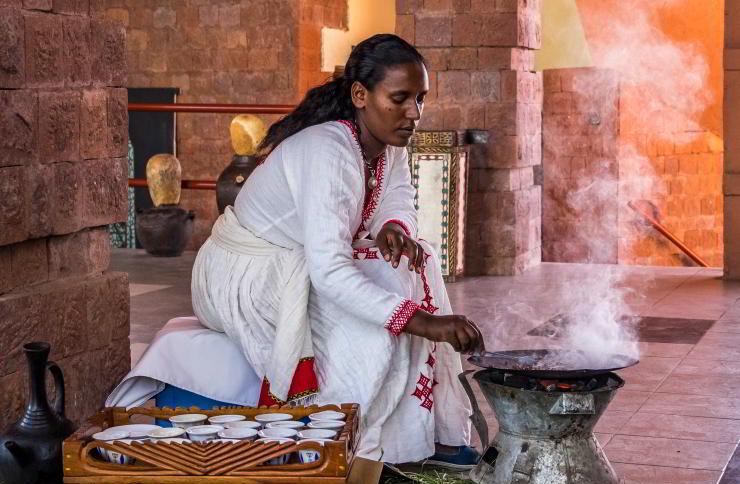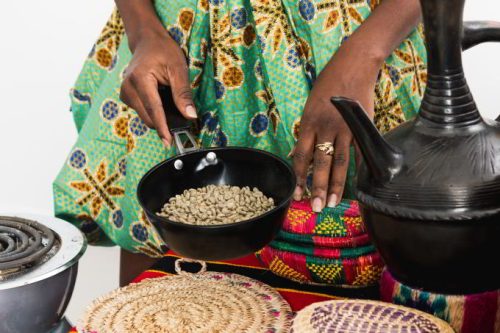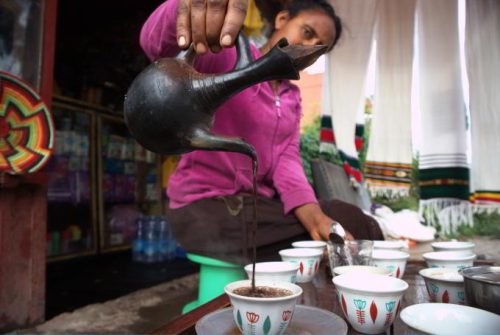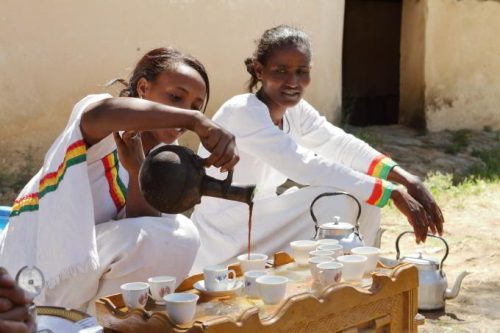Ethiopia. The coffee ceremony.

In the African country where coffee originated, women perform a magical ritual. The preparation of the popular drink resembles a religious liturgy marked by solemn gestures that have been passed down for centuries with the smoke of incense, prayers to the spirits and prophecies of the future.
In Ethiopia, the homeland of coffee, each family roasts its own beans, pounds them in a mortar and offers the drink to guests following a solemn ritual, with a strong symbolism of hospitality, friendship and respect.The preparation of Ethiopian coffee (called bunna by the local population) is long and evocative, an integral part of daily life and common to all social classes. A woman, usually the lady of the house, is in charge of officiating and the ritual.
Guests are welcomed into a room, where they are invited to sit in a circle. A carpet of freshly cut grass stems or sprigs of rue is laid out on the floor, giving off a pleasant scent. A small table serves as a support for the traditional cups without handles.

Preparing Ethiopian coffee is long and evocative, an integral part of daily life.Shutterstock/vivver
The mistress of ceremonies lights the incense, whose bittersweet vapours purify the air in the room and accentuate the sacredness of the moment. The woman roasts the beans, shaking them in a hollow bowl to toast them just the right amount, then shows them to the guests so that the aroma of the coffee spreads throughout the room.
The powder obtained by grinding the beans in a wooden mortar is poured into the jabana, the traditional coffee pot, filled with boiling water: it is a round clay jug with a potbelly at the base and a long neck that ends in a thin spout.

An Ethiopian woman pours Ethiopian coffee from a traditional coffee pot into small cups. Shutterstock/Stewart Innes
When the coffee boils, a little is poured into a cup to cool it, and then it is put back into the coffee pot. At this point, the coffee is ready to be offered to the guests. It is served by slowly turning the coffee pot upside down so that the powder remains deposited on the bottom. Sometimes a filter made of horsehair or other material is used.
The hostess pours the hot coffee, serving the guests with small cups with no handles, without stopping until each cup is full. She then adds sugar and, often, a sprig of rue. The taste is full-bodied, intense and not bitter. The ceremony is accompanied by songs and prayers. A small cup is poured in honour of the spirits.

The coffee ceremony is an important part of the Ethiopian culture. Shutterstock/hecke61
The mistress of ceremonies blesses the coffee and the women raise their palms upwards as if in prayer. Tradition dictates that three cups be offered. The first (called abol or awel in Tigrinya), already sweetened, is served to the eldest person, then the other two (tona and baraka) are served, obtained by adding water to the jabana from time to time. The three coffees are served with corn, wheat or toasted barley. The preparation of the popular drink is shrouded in an aura of mysticism and magic. At the end of the ceremony – in many ways similar to a religious liturgy – the officiant shows off his clairvoyant skills and interprets the signs of destiny in the dregs of the cups. (Open Photo: A Young woman in traditional clothing is preparing a coffee ceremony. Shutterstock.com/Rudi Ernst)
Claudia Nuzzo/Africa



